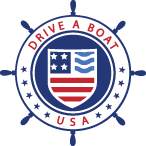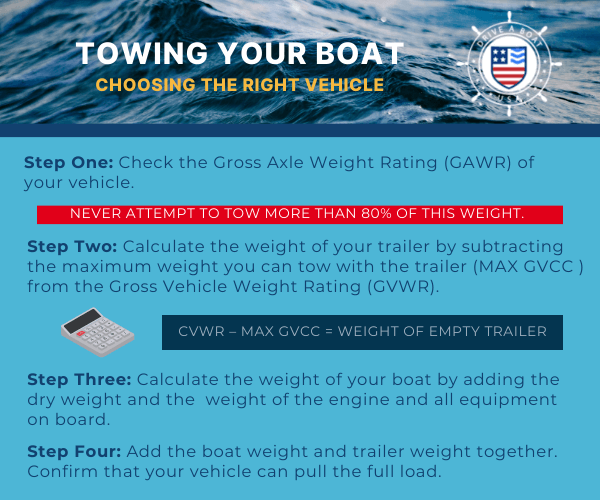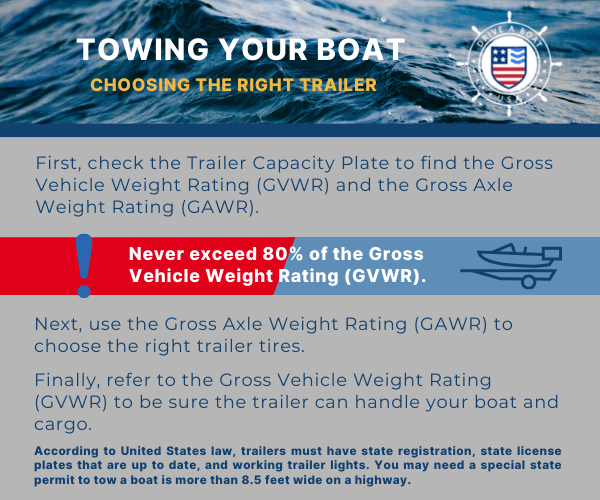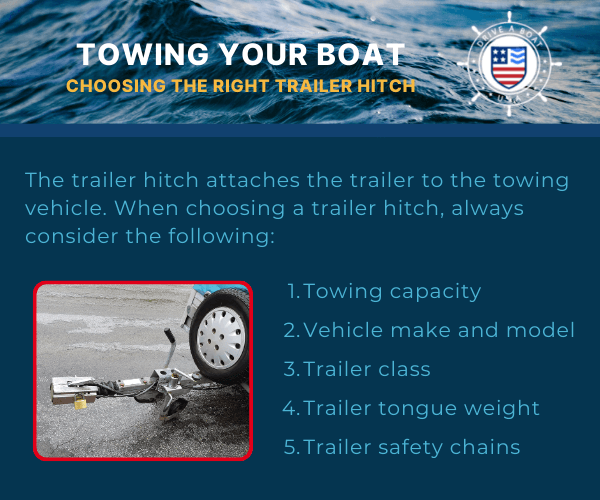Guide to Towing and Trailering a Boat
Most boats are not left tied to the dock. Instead, they are towed, or trailered, from storage to the location where they will be used.
Towing a boat is not difficult, but there are several important factors you need to take into consideration to do it correctly. The last thing you want is to damage your boat or towing vehicle and miss your day on the water!
Towing a boat involves correctly choosing and using a trailer hitch, trailer and towing vehicle. You may also need other basic equipment like safety chains and rollers and/or pads. You will need to locate and read the trailer capacity plate and make sure all elements of your towing kit are compatible. You will need to maintain your trailer, just as you maintain your boat, and be sure that everything is in good working condition before use. Driving a vehicle with a boat in tow requires some extra skill and might even take a bit of practice.
Trailering a boat involves following a step-by-step procedure and putting safety first. Let’s look at what you need to do to successfully tow your boat.
Part One: Choosing the right towing equipment
Trailering a boat requires an appropriate vehicle, trailer and trailer hitch. There are specific rules and regulations governing the exact type of equipment you can use to trailer a boat.
Choosing the right vehicle to tow a boat
Is your towing vehicle up to the task? You can’t just trust your gut on this one – you need to check the Gross Axle Weight Rating to be sure your vehicle can safely handle the load.
Gross Axle Weight Rating (GAWR)
The Gross Axle Weight Rating (GAWR) refers to the maximum amount of weight the axle of a vehicle is designed to carry. You can find it in your owner’s manual. Never attempt to tow more than 80% of this weight.
To determine how much your trailer weighs:
- Look at the VIN sticker on your trailer (which is the equivalent of the HIN on your boat) and find the Gross Vehicle Weight Rating (GVWR). This indicates the empty weight of the trailer plus the maximum possible weight you can haul with the trailer (also called the MAX GVCC). Take the CVWR and subtract the MAX GVCC and you have the empty weight of your trailer. (CVWR – MAX GVCC = weight of empty trailer)
To determine how much your boat weighs:
- First you need to figure out the dry weight of your boat, which is the weight of the boat out of the water. To do this, you can visit a truck stop or feedlot and get it weighed on a public scale, or ask your dealer for help. Remember, your Boat Capacity Plate indicates how much weight you can take on your boat, and not the weight of the boat.
- Note the dry weight of your boat, and add the weight of everything that you will be adding to it before trailering. This can include the engine, accessories like Visual Distress Signals and PFDs, and any cargo. Calculate the weight of the gas in pounds by multiplying the fuel tank capacity by 7. Calculate the weight of any water aboard the boat in pounds by multiplying each gallon by 8.
Add the boat weight and trailer weight together, and there you have the total weight your vehicle will be hauling. Remember that if you haul a load that exceeds the GAWR, you put yourself and others at risk, and any damage incurred will not be covered by your insurance.
Choosing the right boat trailer
How can you tell whether your trailer is capable of handling the weight of your boat? Check the Trailer Capacity Plate.
Trailer Capacity Plate
Your Trailer Capacity Plate will indicate how much weight you can put on the trailer, the Gross Vehicle Weight Rating (GVWR). When you calculate the weight of your load, remember to include the weight of your boat, engine, fuel, accessories and any other gear that will be on board when you tow the boat. Be sure their combined weight does not exceed 80% of the GVWR of your trailer.
Federal law classes trailers according to their GVWR:
- GVWR- 2000 lbs. (Class 1)
- GVWR- 3500 lbs. (Class 2)
- GVWR- 5000 lbs. (Class 3)
- GVWR- 5000 lbs. or more (Class 4)
The Trailer Capacity Plate will also indicate the Gross Axle Weight Rating (GAWR), which you can use to choose the right tires for your trailer. Tire rating must be at least equal to the GAWR. You may need heavy-duty tires for a big load!
You will also need rollers and/or pads are used to support the boat on the trailer.
Remember: According to Uniter States law, trailers must have state registration, state license plates that are up to date, and working trailer lights. You may need a special state permit to tow a boat is more than 8.5 feet wide on a highway.
How to choose the right trailer hitch
The trailer hitch is what attaches the trailer to the towing vehicle. It consists of a socket on the front of the trailer, and a ball on the vehicle. The socket drops over the ball and locks down. The socket should be permanently attached to the towing vehicle.
Make sure you consider the following when choosing a trailer hitch:
- Towing capacity: Your hitch’s towing capacity has to meet or exceed the weight of the trailer you plan to tow.
- Vehicle make and model: Knowing your make and model can help you choose a hitch that is compatible and fits your vehicle correctly.
- Trailer class: Select a hitch that aligns with your towing needs and your vehicle’s capabilities. Choose a ball size according to the trailer class.
- Trailer tongue weight: The tongue weight is the downward pressure the coupler places on the ball. The ideal tongue weight should be roughly 10% of the total weight your boat and trailer.
Trailer safety chains: These chains possess the strength to bear the entire load, and play a critical safety role should the hitch fail. Choose chains that are guaranteed to be capable of supporting your load.
Step Two: Preparing to tow your boat
You’ve chosen the right combination of trailer, hitch and vehicle. Now let’s get this show on the road!
Hitching up your trailer
Follow these steps to hitch up your boat trailer safely and securely:
- Verify that the trailer is appropriately balanced and level before connecting it to the vehicle. A poorly loaded trailer will be unstable and could be difficult to handle on the road.
- Verify that all cargo and equipment are tied down and fastened securely. If heading home, drain any accumulated water from the boat’s bilge. Never store gas tanks in the trunk of the vehicle. Align the vehicle and trailer so that the hitch ball is directly beneath the trailer’s socket, then gradually lower the trailer.
- Securely attach the tongue and ball and lock the trailer hitch.
- Use tie-down straps to firmly secure the boat to the trailer.
- Confirm that the trailer’s safety chains are fastened securely to the hitch. The chains should be long enough for tight turns but short enough to prevent the trailer tongue from touching the road if dislodged from the hitch. Always cross the chains beneath the trailer tongue.
- Attach the trailer’s lighting harness to your vehicle, so that other drivers will know when you are stopping, braking or turning.
- Verify your trailer’s tire pressure and lug nuts, and test the brakes. Adjust your side view mirrors to be sure you have a clear view of the trailer and the traffic behind you.
Be sure that the trailer is hitched correctly and well balanced. Too much weight on the rear of the trailer can cause it to fishtail, while too much weight on the hitch can make it difficult to steer.
Step Three: Driving with your boat in tow
It can take some patience and a bit of know-how to successfully drive with a boat trailer in tow. Remember, your vehicle is longer and heavier with a trailer behind it, and it will be less responsive. You will need to adjust accordingly. Here are a few important tips:
- Practise backing up and turning with the trailer attached. The trailer will turn in the opposite direction of the towing vehicle, which can take some getting used to. It’s best to practise somewhere calm like a deserted parking lot before heading out onto the highway.
- Drive more slowly than usual.
- Remember that you will take longer to slow down and stop with your trailer in tow.
- You will have to accelerate more slowly.
- Turns will require a larger radius with your trailer attached. Give curbs and barriers a wide berth.
- High winds, heavy rain, fog and ice can all pose an ever greater risk when towing a boat. It is not wise to operate a boat on rough water or when a Small Craft Advisory is in effect, so if you are acing bad weather, consider postponing your trip.
- Make sure your mirrors are large enough for you to see the road and traffic clearly.
Get your state-approved boating license from Drive a Boat USA
When towing your boat, remember to confirm that you have all necessary boating safety equipment and that you remember to take your boat’s key with you. Always file a float plan before heading out on the water, and consider bringing someone along when you tow your boat, so you can rely on each other in case of emergencies.
Learn more about safe boating in New York, California and Florida and get a state-approved boating licence from Drive A Boat USA. Start today!
